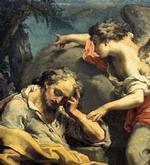Catholic Activity: Story of St. Paul the Hermit
Of the many men who during the early Christian centuries fled to live in the desert, Saint Paul the Hermit was the earliest. We have this on the testimony of none other than Saint Anthony who came there thinking that he himself was the first.
DIRECTIONS
Then, as The Golden Legend of Jacobus de Voragine tells the story, "he learned in a dream that another anchorite, better than himself, had a claim to this homage. Therefore, Saint Anthony bent every effort to discover the whereabouts of this other hermit. And searching through the forests, he came first upon a hippocentaurus, half man and half horse, who told him to go to the right. Next he met an animal who was carrying some dates; the upper part of his body was that of a man, but he had the belly and feet of a goat. Anthony asked him what he was; and he answered that he was a satyr, that is, one of those creatures which the pagans mistook for wood-gods. Finally Saint Anthony came face to face with a wolf, who led him to the cell where Saint Paul dwelt. But he, being aware of the approach of a man, had closed his door. Anthony besought him to open to him, declaring that he would die on the spot rather than go away. And Paul, yielding to his prayers, opened the door, and at once the two hermits embraced each other with great affection.
"When the noon-hour drew near, a crow flew down, bearing a loaf formed of two halves. Anthony wondered at this, but Paul told him that God provided him daily with food in this manner; this day the quantity was doubled, on account of Anthony's visit. Thereupon they disputed piously over which of them was more worthy to divide the loaf. Paul wished that Anthony should do it, since he was the guest. Anthony insisted that it be Paul, who was the older. In the end both took hold of the loaf, and broke it in two."
De Voragine does not go on to state the nature of the loaf, but we like to think of it as one of the simplest and best of whole wheat loaves.






